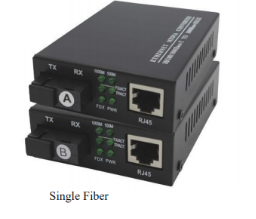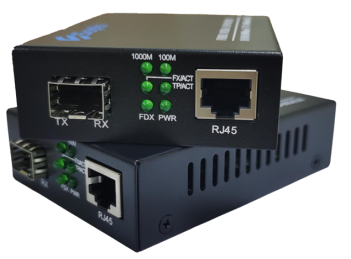1. What is single-mode single fiber and single-mode dual fiber?
Single-mode or multi-mode depends on the optical cable. Single-mode refers to the use of single-mode optical cables, and single-fiber or dual-fiber refers to one-core optical fiber transmission or two-core optical fiber transmission.
2. What is a single-mode single-fiber media converter?
The single-fiber media converter uses only one core, and both ends are connected to this core. The media converters at both ends use different optical wavelengths, so optical signals can be transmitted in one core, that is, data can be received on one optical fiber. And send. Compared with the single-mode dual-fiber media converter, the single-mode single-fiber media converter can save half of the fiber, so it is very suitable in places where fiber resources are tight. In order to transmit data on an optical fiber, this type of product uses wavelength division multiplexing technology, generally using two wavelengths of 1310nm and 1550nm, so single-fiber media converter products generally have the characteristic of large signal attenuation. Therefore, the optical module of the single-mode single-fiber media converter has two wavelengths of light emitted, generally 1310nm/1550nm, so there will be a difference between the two ends of the interconnection of a pair of media converters. One end of the media converter emits 1310nm and receives 1550nm. The other end is transmitting 1550nm and receiving 1310nm,
So in order to facilitate the user to distinguish, letters are generally used instead. There will be A-end (1310nm/1550nm) and B-end (1550nm/1310nm). The user must use AB pairing, not AA or BB connection. Only the single-fiber fiber media converter will be used at the AB end.

3. What is a single-mode dual-fiber optical media converter?
The single-mode dual-fiber media converter uses two cores, one for sending and the other for receiving, one end is sending and the other end must be inserted into the receiving port, that is, the two ends must be cross-connected. The single-mode dual-fiber media converter transmits through two optical fibers, and each optical fiber is one-way transmission. The wavelengths used are the same at 1310nm, so the loss is small and stable. Although more optical fibers are needed, it is currently on the market. Optical media converters are still based on dual-fiber products. Dual-fiber generally has two ports. The two ports of dual-fiber are relatively close. They are marked with TX and RX, one for sending and one for receiving, which are designated. TX port (transmitting port) ) And RX port (receiving port).

4. Can single-mode single-fiber media converter and single-mode dual-fiber media converter be interconnected?
Theoretically speaking, dual-fiber media converters should be able to be connected. Now the standard of fiber media converters is unified. Most manufacturers' single-mode dual-fiber media converters are compatible with each other; single-fiber media converters can also be used, but due to power and sensitivity issues, the effect of mixing and matching is not effective. It will be very good. It is recommended to choose products from the same manufacturer as much as possible, which is also easier to handle in terms of maintenance after-sales.
5. Is there a fiber media converter divided into one for the receiving end and the other for the transmitting end? Or just two optical fiber media converters can be used as a pair?
Generally, single-mode dual-fiber media converters do not distinguish between transmitter and receiver, as long as they appear in pairs, they can be used. Only a single-fiber media converter (one fiber is required for normal communication) will have a transmitter and receiver. Different speeds and different wavelengths cannot communicate with each other. In addition, even a single-fiber media converter of the same brand and a pair of dual-fibers cannot communicate with each other.